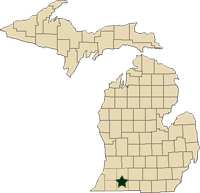Regional report on southwest Michigan field crops – April 19, 2012
MSU Extension educators’ pest and field crop updates for southwest Michigan.
This week’s regional reports:
- Southwest Michigan – Bruce Mackellar
Southwest Michigan – Bruce Mackellar, Michigan State University Extension
|
Weather
For those of us who wanted a “normal” planting season for a change, well, there is always next year. Record high temperatures in March allowed for a lot of early season work, which was great. However, April has brought us a reality check. Several freeze events with below normal temperatures during the first two weeks of April has put the brakes on widespread planting activities. Soil temperatures have moved in the wrong direction since the first of April, with soil temperatures under sod at the Watervliet Enviro-weather Station ranging between 45 and 50°F last week. Rainfall accompanied with warmer temperatures over the weekend of April15 has left fields a bit warmer, but soggy in most areas.
Rainfall totals from this storm across the 13 stations in southwest Michigan averaged 1.39 inches, with Lawton, Mich., receiving the least at 0.7 inches, and Harford, Mich., receiving the most at just under 2 inches. Overall, soil moisture has been pretty good, with the average rainfall totals since March 1 around 3.85 inches of precipitation.
Growing degree day (GDD) accumulation for early growth and development has been pretty much off the charts because of the warm March conditions. This impacts wheat and alfalfa growth, as well as many of the overwintering insect pests and weed species. We are currently over 500 GDDs base 41 since March 1. We generally suggest harvesting first cutting alfalfa around the 750 GDD mark for top quality dairy forage.
Commodity reports
Wheat growth continues to be way ahead of schedule across the region. My reference field at home is at late Feeke’s Stage 6 to early Feeke’s Stage 7 (second node just visible). There appears to be some nitrogen related injury on a few fields, most likely made worse by the variable temperatures. Most fields look pretty good. We are making an effort to get armyworm pheromone traps up in several locations across the state.
Alfalfa growth was off to a great start before the freezes. Most fields look as though they will recover nicely. Watch fields for alfalfa weevil larval feeding injury. Thresholds preharvest are 40 percent of stems damaged, plus live larvae present.
Corn and soybeans. Planting was underway for a limited number of acres for both corn and soybeans. We will be approaching the beginning of the normal spring planting season next week. For those of you that are thinking of starting as soon as the soil dries, you might want to think about the soil temperatures at the time of planting. The temperature of the water taken up by the seed during the first 24 to 36 hours after planting can cause germination and seedling root development issues, leading to stand loss, unevenness and seedling vigor issues. Similar challenges can occur in soybeans. The soil temperatures for the first one to two days after planting may be more important than light frosts following seedling emergence. We have a wealth of information available on soil temperatures from the MSU Enviro-weather stations across southwest Michigan.
A great deal of tillage was completed in March and early April. This should reduce the chance that black cutworm damage will occur on these fields. MSU entomologist Chris DiFonzo said recently that early flight had been reported in traps in northern Indiana. With a strong push of warm air from the southwest and thunderstorms on April 15, moths may have arrived in our area. Fields that had mats of winter annual weeds or cover crops on them may have made attractive locations to lay eggs. Many fields tilled last fall are beginning to show the initial signs of weed growth over the past couple of days. MSU weed specialist Christy Sprague wrote an excellent article on the impact of low temperatures on burn-down herbicides, which was also a hot topic around southwest Michigan last week.



 Print
Print Email
Email



